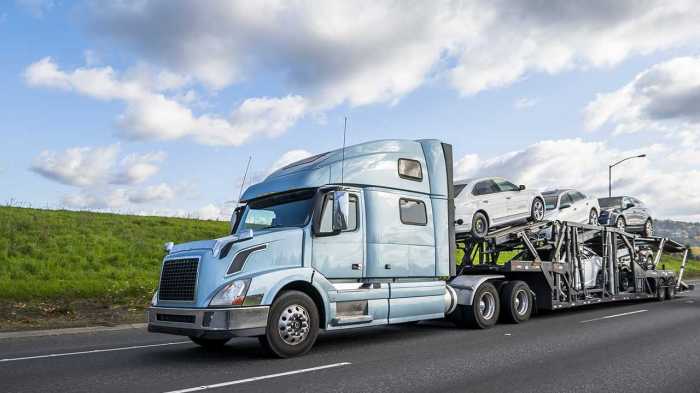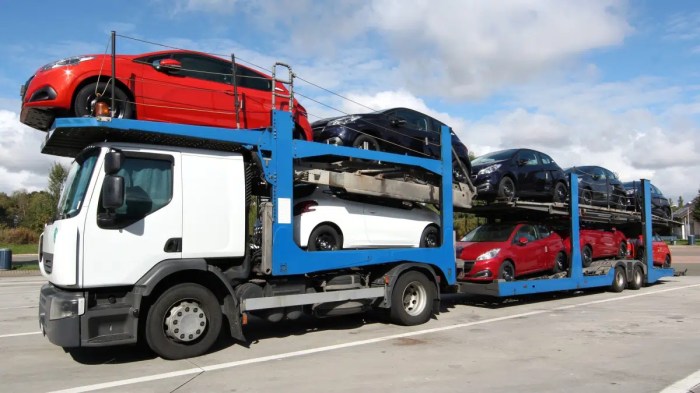Types of Car Shipping Services
Choosing the right car shipping method depends on your budget and how much protection you want for your vehicle. Two primary methods exist: open and enclosed transport. Understanding the differences between these, and the variations within each, is crucial for making an informed decision. This section will Artikel the advantages and disadvantages of each, enabling you to select the best option for your needs.
Open vs. Enclosed Transport
Open transport is the most common and generally the cheapest method. Your car is transported on an open trailer, exposed to the elements. Enclosed transport, conversely, uses a covered trailer, protecting your vehicle from weather, debris, and potential damage during transit. The choice hinges on the value of your vehicle and your tolerance for risk.
Advantages and Disadvantages of Open Transport
Open transport offers significant cost savings. Because it’s more efficient to load and unload, and requires less infrastructure, the shipping companies can pass these savings on to their customers. However, this cost-effectiveness comes at the expense of protection. Your vehicle is exposed to the elements, potentially leading to scratches, dents, or damage from road debris. This is especially concerning for newer or more valuable vehicles.
Transit times are generally faster with open transport due to higher efficiency.
Advantages and Disadvantages of Enclosed Transport
Enclosed transport provides superior protection for your vehicle. The enclosed trailer shields it from the elements and road debris, minimizing the risk of damage during transit. This is particularly beneficial for high-value vehicles, classic cars, or vehicles with a custom paint job. However, the enhanced protection comes at a higher cost. Enclosed transport is significantly more expensive than open transport due to the increased cost of the trailers and the reduced number of vehicles that can be transported per trip.
Transit times may also be slightly longer due to logistical factors.
Expedited vs. Standard Shipping
Both open and enclosed transport offer expedited and standard shipping options. Standard shipping is the most common and offers a balance between cost and transit time. Expedited shipping prioritizes faster delivery, but at a premium cost. The specific transit time for both standard and expedited shipping will vary based on distance and current logistical conditions. For example, shipping a car across the country using standard open transport might take 7-10 business days, whereas expedited shipping could reduce that to 3-5 business days, at a considerable cost increase.
Comparison Table: Open vs. Enclosed Transport
| Feature | Open Transport | Enclosed Transport |
|---|---|---|
| Cost | Lower | Higher |
| Transit Time (Estimate) | 7-10 business days (Standard); 3-5 business days (Expedited) | 10-14 business days (Standard); 5-7 business days (Expedited) |
| Risk Level | Higher (exposure to elements and road debris) | Lower (protected from elements and debris) |
| Protection Level | Lower | Higher |
Finding Reputable Companies

Choosing a car shipping company requires careful consideration to avoid potential problems and ensure a smooth, reliable transport process. Many companies operate in this industry, and not all prioritize customer satisfaction or maintain high operational standards. Thorough research is crucial to safeguard your vehicle and your investment.Finding a reputable car shipping company involves a multi-faceted approach. It’s not simply about finding the cheapest option; prioritizing reliability and trustworthiness is paramount.
A seemingly low price might mask hidden fees, inadequate insurance, or a lack of proper licensing, leading to significant problems down the line. Therefore, understanding how to vet potential companies is essential.
Licensing and Insurance Verification
Verifying a company’s licensing and insurance is a crucial step in ensuring legitimacy and protection. Operating without the proper licenses demonstrates a disregard for regulations and potentially indicates a higher risk of scams or unprofessional practices. Similarly, insufficient insurance coverage leaves your vehicle vulnerable to damage or loss without adequate compensation. You should independently verify the validity of their licenses through your state’s Department of Transportation or similar regulatory bodies.
Confirm that their insurance coverage is sufficient to cover the value of your vehicle. Don’t hesitate to request proof of both licensing and insurance documentation before making a commitment. Reputable companies will readily provide this information.
Analyzing Customer Reviews and Testimonials
Customer reviews offer valuable insights into a company’s performance and reliability. Websites like the Better Business Bureau (BBB) and independent review platforms provide a wealth of information from past clients. Look for consistent patterns in feedback; a few negative reviews are normal, but a significant number of negative experiences should raise concerns. Pay close attention to details such as communication responsiveness, handling of issues, and the overall quality of service.
Positive reviews detailing smooth transport experiences and efficient customer service are strong indicators of a reputable company. However, remember that reviews can be manipulated, so it’s important to consider the overall picture and not just focus on the star rating alone.
Questions to Ask Potential Car Shipping Companies
Before committing to a car shipping company, it’s crucial to ask specific questions to assess their capabilities and commitment to customer service. This proactive approach helps clarify expectations and avoid potential misunderstandings.
- What is your company’s licensing and insurance information, and can you provide documentation?
- What is your exact pricing structure, including any potential additional fees?
- What is your estimated delivery timeframe, and what factors could affect it?
- What is your process for handling vehicle damage during transport, and what is your insurance coverage?
- What is your communication policy, and how will you keep me updated throughout the shipping process?
- Can you provide references or contact information for previous clients?
- What is your method for handling disputes or complaints?
Hidden Costs and Fees
Securing the lowest quote for car shipping is only half the battle. Many companies employ strategies that inflate the final price beyond the initial estimate. Understanding these hidden costs is crucial to avoid unexpected expenses and ensure a smooth, budget-friendly transport process. Failing to account for these additional charges can significantly impact your overall budget and potentially lead to financial strain.Hidden fees in car shipping can quickly add up, transforming a seemingly affordable quote into a substantially more expensive undertaking.
These unexpected costs can arise from various sources, and being aware of them beforehand is key to making an informed decision and choosing the right shipping provider. This section will highlight common hidden fees and provide strategies for avoiding them.
Common Hidden Fees in Car Shipping
Several fees often go unmentioned in initial quotes, leaving customers surprised by the final bill. These hidden costs can significantly increase the total price, sometimes by hundreds of dollars. It’s essential to inquire about these fees upfront to avoid unpleasant surprises.
- Fuel Surcharges: Fuel prices fluctuate constantly. Many companies add a fuel surcharge to their base price, which isn’t always clearly stated upfront. This surcharge can vary depending on the distance and current fuel costs. For example, a 1000-mile shipment might see a surcharge of $100-$200 depending on the time of year and prevailing fuel prices.
- Handling Fees: These fees cover the loading and unloading of your vehicle. Companies might charge extra for vehicles requiring specialized handling, such as those with low ground clearance or requiring ramps. For example, a large SUV might incur a higher handling fee than a standard sedan.
- Insurance Costs: While basic liability insurance is often included, comprehensive coverage may cost extra. This covers damage to your vehicle during transit, which can be quite costly if an accident occurs. Opting for additional coverage will add to the overall cost, but it offers greater peace of mind.
- Terminal Fees: These fees are charged for storing your vehicle at a terminal, either at the origin or destination. Delays in pickup or delivery can lead to increased terminal fees, as can issues with paperwork or unforeseen logistical problems. A delay of a few days could result in an additional fee of $50-$100.
- Administrative Fees: Some companies tack on administrative fees for paperwork processing, which are often small but can accumulate if multiple charges are applied.
Strategies for Avoiding Hidden Fees
Proactive steps can significantly minimize the risk of unexpected charges. By carefully researching and negotiating, you can keep your car shipping costs under control.
- Obtain a Detailed Quote: Request a comprehensive quote that explicitly lists all fees, including fuel surcharges, handling fees, insurance costs, and any other potential charges. Don’t settle for a vague estimate.
- Compare Multiple Quotes: Get quotes from several reputable companies to compare pricing and fee structures. This allows you to identify potential hidden costs and choose the most transparent option.
- Read the Fine Print: Carefully review the contract before signing. Pay close attention to the terms and conditions, especially sections outlining additional fees or charges.
- Inquire About All Fees Upfront: Don’t hesitate to ask the company about any unclear or unspecified charges. A reputable company will be happy to provide a clear and detailed explanation.
- Consider Your Vehicle’s Characteristics: Be upfront about your vehicle’s features (low ground clearance, modifications, etc.) that might affect handling fees. This will help avoid surprises later.
Negotiating Prices and Getting the Best Deal

Securing the lowest possible car shipping rate requires a proactive approach. Don’t simply accept the first quote you receive; instead, leverage your research and negotiation skills to find the best value. Remember, companies often have some flexibility in their pricing, particularly during slower periods or with less-demanding routes.Effective negotiation involves more than just asking for a lower price.
It’s about demonstrating your understanding of the market and presenting a compelling case for a discount.
Comparing Quotes and Identifying Best Value
Comparing quotes from multiple car shipping companies is crucial for securing the best deal. This involves more than simply looking at the bottom line. You need to analyze the entire package, considering factors beyond just the initial price. For example, two companies might offer seemingly similar prices, but one may include insurance while the other charges extra. Another might offer faster delivery, a critical factor for some.
To compare effectively, create a spreadsheet or use a comparison tool to list all quotes side-by-side. Include all charges – the base price, insurance, taxes, and any additional fees. Then, calculate the total cost for each quote and assess the overall value based on the services provided. For instance, Company A might offer a slightly higher base price but include comprehensive insurance, making it a better overall value than Company B, which has a lower base price but charges extra for insurance.
Negotiating Strategies
Several strategies can be employed to negotiate lower car shipping rates. First, always obtain multiple quotes. This gives you leverage to compare prices and highlight discrepancies. Second, inquire about discounts. Many companies offer discounts for seniors, military personnel, or repeat customers.
Third, be prepared to negotiate. Don’t be afraid to politely ask for a lower price, particularly if you’ve received significantly lower quotes from competitors. Fourth, be flexible with your shipping dates. Shipping during off-peak seasons or less popular times often results in lower rates. Finally, consider alternative delivery locations.
If you’re flexible on where your car is delivered, you might find a cheaper option. For example, if you are willing to have your car delivered to a nearby port instead of directly to your house, this could potentially lower the cost.
The Importance of Written Agreements
Before committing to any car shipping company, ensure all terms and conditions are documented in a written contract. This contract should explicitly state the agreed-upon price, including all fees and charges, the pickup and delivery dates and locations, the type of shipping method, insurance coverage, and the company’s liability in case of damage or loss. A written agreement protects you from unexpected costs or disputes.
If a verbal agreement is made, and something goes wrong, it can be extremely difficult to resolve the issue without written proof. Always carefully review the contract before signing. If anything is unclear or seems unreasonable, don’t hesitate to ask for clarification or negotiate changes. For instance, if the contract doesn’t clearly specify the type of insurance coverage, request a more detailed explanation or a revised contract with explicit details.
Protecting Your Vehicle During Shipping
Shipping your car can feel stressful, but taking proactive steps to protect it minimizes the risk of damage during transit. Proper preparation, comprehensive documentation, and adequate insurance are crucial for a smooth and worry-free experience. This section details how to safeguard your vehicle throughout the shipping process.Preparing your vehicle for shipment involves more than just cleaning it. Thorough preparation significantly reduces the chances of scratches, dents, or other damage.
Taking the time to document your vehicle’s pre-existing condition is also essential for resolving any potential disputes.
Vehicle Preparation for Shipping
Before handing your car over to the shipping company, perform a thorough inspection and take detailed photographs or videos of its condition. Note any existing scratches, dents, or imperfections. This documented evidence serves as proof of the vehicle’s condition before shipment, protecting you in case of disputes with the shipping company. Clean your vehicle inside and out; this helps identify any pre-existing damage more easily and also makes it easier for the driver to assess its condition.
Consider removing any personal belongings from the vehicle, including valuable items, loose objects, and anything that might shift during transit. Deflate your tires slightly to prevent damage from pressure changes during transport.
- Take detailed photos and videos of your vehicle’s exterior and interior, focusing on any existing damage.
- Thoroughly clean the interior and exterior of your vehicle.
- Remove all personal belongings, valuable items, and loose objects.
- Slightly deflate your tires to prevent damage from pressure changes.
- Disable the alarm system to prevent accidental triggering during transport.
Documentation and Insurance Coverage
Comprehensive documentation and insurance are vital for protecting your investment. The shipping company should provide you with a Bill of Lading, which acts as a contract outlining the terms of the shipment and details the vehicle’s condition. Ensure you receive a copy and review it carefully. Additionally, consider purchasing additional insurance coverage beyond what the shipping company offers, especially if your vehicle is high-value or has sentimental significance.
This extra layer of protection will safeguard you against unforeseen circumstances such as damage or loss. Always obtain proof of insurance and keep a copy for your records.
- Obtain and carefully review the Bill of Lading, ensuring all details are accurate.
- Purchase additional insurance coverage to protect against unforeseen circumstances.
- Keep copies of all documentation, including the Bill of Lading, insurance policy, and any communication with the shipping company.
Pre-Shipping, During Shipping, and Post-Shipping Checklist
Before shipping, confirming all details with the company is crucial to prevent delays and issues. During shipping, tracking the vehicle’s location provides peace of mind. After delivery, a thorough inspection is essential to ensure the vehicle arrived undamaged.
- Before Shipping: Confirm pickup date and time, review the Bill of Lading, and ensure your vehicle is properly prepared.
- During Shipping: Track your vehicle’s location using the provided tracking information, and contact the shipping company if you have any concerns.
- After Shipping: Perform a thorough inspection of your vehicle for any damage and immediately report any issues to the shipping company.
Illustrative Example: A Cross-Country Car Shipment

This section provides a hypothetical example of a cross-country car shipment from New York City to Los Angeles, illustrating the cost variations based on different shipping methods and companies. We will explore the total cost breakdown, including potential hidden fees, to give you a clearer picture of what to expect. This example uses estimated prices, and actual costs may vary depending on several factors, including the time of year, fuel prices, and the specific vehicle being shipped.
Cost Comparison for Different Shipping Methods
The following table compares the estimated costs of shipping a standard-sized sedan from New York City to Los Angeles using different shipping methods and companies. These are estimates and should not be considered firm quotes. Always obtain personalized quotes from multiple companies before making a decision.
| Shipping Method | Company A (Open Transport) | Company B (Open Transport) | Company C (Enclosed Transport) |
|---|---|---|---|
| Estimated Base Price | $1200 | $1100 | $2500 |
| Fuel Surcharge (estimated) | $100 | $80 | $200 |
| Insurance (optional, estimated) | $50 | $75 | $150 |
| Pickup/Delivery Fees (estimated) | $150 | $100 | $200 |
| Total Estimated Cost | $1500 | $1355 | $3050 |
Detailed Cost Breakdown for Open Transport (Company A)
This section provides a more detailed breakdown of the estimated costs associated with using Company A for open transport. Remember that these are estimates, and your actual costs may differ.
The base price of $1200 reflects the core cost of transporting the vehicle across the country using open transport. The fuel surcharge of $100 is an additional cost that varies based on fluctuating fuel prices and the distance traveled. Insurance, while optional, is highly recommended to protect your vehicle against potential damage during transit. The estimated cost for insurance in this example is $50.
Finally, pickup and delivery fees cover the cost of picking up your vehicle from your location and delivering it to your destination. This is estimated at $150. Adding these costs together, the total estimated cost for this scenario is $1500.
Factors Affecting the Total Cost
Several factors influence the final cost of car shipping, including vehicle size and type, the distance of the shipment, the time of year (peak seasons tend to be more expensive), and the level of insurance coverage selected. Additional services, such as expedited shipping, also contribute to the overall cost. For instance, shipping a large SUV will typically cost more than shipping a compact car, and shipping during peak travel seasons (summer and holidays) usually results in higher prices due to increased demand.